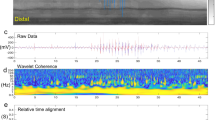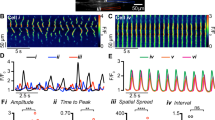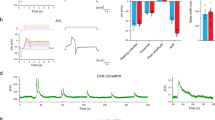Abstract
The motility of the gastrointestinal tract consists of local, non-propulsive mixing (pendular or segmental) and propulsive (peristaltic) movements1,2,3,4,5. It is generally considered that mixing movements are produced by intrinsic pacemakers which generate rhythmic contractions4,5,6, and peristalsis by intrinsic excitatory and inhibitory neural reflex pathways1,2,3,4,5,7,8, but the relationship between mixing and peristalsis is poorly understood4,5,6. Peristalsis is compromised in mice lacking interstitial cells of Cajal9, suggesting that these pacemaker cells10,11,12,13,14 may also be involved in neural reflexes. Here we show that mixing movements within longitudinal muscle result from spontaneously generated waves of elevated internal calcium concentration which originate from discrete locations (pacing sites), spread with anisotropic conduction velocities in all directions, and terminate by colliding with each other or with adjacent neurally suppressed regions. Excitatory neural reflexes control the spread of excitability by inducing new pacing sites and enhancing the overall frequency of pacing, whereas inhibitory reflexes suppress the ability of calcium waves to propagate. We provide evidence that the enteric nervous system organizes mixing movements to generate peristalsis, linking the neural regulation of pacemakers to both types of gut motility.
This is a preview of subscription content, access via your institution
Access options
Subscribe to this journal
Receive 51 print issues and online access
$199.00 per year
only $3.90 per issue
Buy this article
- Purchase on Springer Link
- Instant access to full article PDF
Prices may be subject to local taxes which are calculated during checkout



Similar content being viewed by others
References
Bayliss, W. & Starling, E. H. Movements and innervation of the small intestine. J. Physiol. (Lond.) 24, 99–143 (1899).
Bayliss, W. & Starling, E. H. The movements and innervation of the large intestine. J. Physiol. (Lond.) 26, 107–118 (1900).
Kosterlitz, H. W. & Robinson, J. A. Reflex contraction of the longitudinal muscle coat of the isolated guinea-pig ileum. J. Physiol. (Lond.) 146, 369–379 (1959).
Smith, T. & Sanders, K. in Textbook of Gastroenterology(eds Yamada, T., Alpers, D., Owyang, C. & Powel, D.) 234–260 (Lippincott, Silverstein, Philadelphia, (1995).
Holman, M. in Smooth Muscle and Assessment of Current Knowledge(ed. Bulbring, E.) 311–338 (University of Texas Press, Austin, (1981).
Christensen, J. in Physiology of the Gastrointestinal Tract Vol. 1 (ed. Johnson, L. R.) 991–976 (Raven, New York, (1994).
Hirst, G. D. S., Holman, M. E. & McKirdy, H. C. Two descending nerve pathways activated by distension of guinea-pig small intestine. J. Physiol. (Lond.) 244, 113–127 (1975).
Mackenna, B. R. & McKirdy, H. C. Peristalsis in the rabbit distal colon. J. Physiol. (Lond.) 220, 33–54 (1972).
Huizinga, J. D., Ambrous, K. & Der-Silaphet, T. Co-operation between neural and myogenic mechanisms in the control of distension-induced peristalsis in the mouse small intestine. J. Physiol. (Lond.) 506, 843–856 (1998).
Thomsen, L. et al . Interstitial cells of Cajal generate a rhythmic pacemaker current. Nature Med. 4, 848–851 (1998).
Ward, S. M., Harney, S. C., Bayguinov, J. R., McLaren, G. J. & Sanders, K. M. Development of electrical rhythmicity in the murine gastrointestinal tract is specifically encoded in the tunica muscularis. J.Physiol. (Lond.) 505, 241–258 (1997).
Huizinga, J. D. et al . W/kit gene required for interstitial cells of Cajal and for intestinal pacemaker activity. Nature 373, 347–349 (1995).
Koh, S., Sanders, K. & Ward, S. Spontaneous electrical rhythmicity in cultured interstitial cells of Cajal from the murine small intestine. J. Physiol. (Lond.) 513.1, 203–213 (1998).
Publicover, N. G. in Pacemaker Activity and Intercellular Communication(ed. Huizinga, J. D.) 175–192 (CRC, Boca Raton, (1995).
Cousins, H. M., Edwards, F. R., Hirst, G. D. & Wendt, I. R. Cholinergic neuromuscular transmission in the longitudinal muscle of the guinea-pig ileum. J. Physiol. (Lond.) 471, 61–86 (1993).
Horowitz, B., Ward, S. & Sanders, K. Cellular and molecular basis for electrical rhythmicity in gastrointestinal muscles. Annu. Rev. Physiol. 61, 19–43 (1999).
Ozaki, H., Stevens, R. J., Blondfield, D. P., Publicover, N. G. & Sanders, K. M. Simultaneous measurements of membrane potential, cytosolic Ca2+, and tension in intact smooth muscles. Am. J. Physiol. 260, C917–925 (1991).
Holman, M. E. Membrane potentials recorded with high resistance microelectrodes and the effects of changes in ionic environment on the electrical and mechanical activity of the smooth muscle of the taenia coloi of the guinea pig. J. Physiol. (Lond.) 141, 464–488 (1958).
Gillespie, J. S. Spontaneous mechanical and electrical activity of stretched and unstretched intestinal smooth muscle cells and their response to sympathetic nerve stimulation. J. Physiol. (Lond.) 162, 54–75 (1962).
Smith, T. K., Reed, J. B. & Sanders, K. M. Interaction of two electrical pacemakers in muscularis of canine proximal colon. Am. J. Physiol. 252, C290–299 (1987).
Costa, M. & Furness, J. B. The peristaltic reflex: an analysis of the nerve pathways and their pharmacology. Naunyn Schmiedebergs Arch. Pharmacol. 294, 47–60 (1976).
Smith, T. K. & Robertson, W. J. Synchronous movements of the longitudinal and circular muscle during peristalsis in the isolated guinea-pig distal colon. J. Physiol. (Lond.) 506, 563–577 (1998).
Smith, T. K. & McCarron, S. L. Nitric oxide modulates cholinergic reflex pathways to the longitudinal and circular muscle in the isolated guinea-pig distal colon. J. Physiol. (Lond.) 512, 893–906 (1998).
Costa, M. & Furness, J. B. in Mediators and Drugs in Gastrointestinal Motility I. Morphological Basis of Neurophysiological Control(ed. Bertacchini, A.) 279–382 (Springer, Berlin, (1982).
Smith, T. K. & Furness, J. B. Reflex changes in circular muscle activity elicited by stroking the mucosa: an electrophysiological analysis in the isolated guinea-pig ileum. J. Auton. Nerve Syst. 25, 205–218 (1988).
Tomita, T. Electrical responses of smooth muscle to external stimulation in hypertonic solution. J.Physiol. (Lond.) 183, 450–468 (1966).
Burnstock, G. & Prosser, C. Conduction in smooth muscle, comparative electrical properties. Am. J. Physiol. 199, 553 (1960).
Smith, T. K., Bornstein, J. C. & Furness, J. B. Convergence of reflex pathways excited by distension and mechanical stimulation of the mucosa onto the same myenteric neurons of the guinea pig small intestine. J. Neurosci. 12, 1502–1510 (1992).
Acknowledgements
This work was supported by the National Institute of Diabetes and Digestive and Kidney Diseases.
Author information
Authors and Affiliations
Corresponding author
Rights and permissions
About this article
Cite this article
Stevens, R., Publicover, N. & Smith, T. Induction and organization of Ca2+ waves by enteric neural reflexes. Nature 399, 62–66 (1999). https://doi.org/10.1038/19973
Received:
Accepted:
Issue Date:
DOI: https://doi.org/10.1038/19973
This article is cited by
-
High definition mapping of circular and longitudinal motility in the terminal ileum of the brushtail possum Trichosurus vulpecula with watery and viscous perfusates
Journal of Comparative Physiology B (2007)
-
Translating Trendelenburg; back to the future
Naunyn-Schmiedeberg's Archives of Pharmacology (2006)
-
A calcium window to the gut
Nature (1999)
Comments
By submitting a comment you agree to abide by our Terms and Community Guidelines. If you find something abusive or that does not comply with our terms or guidelines please flag it as inappropriate.



